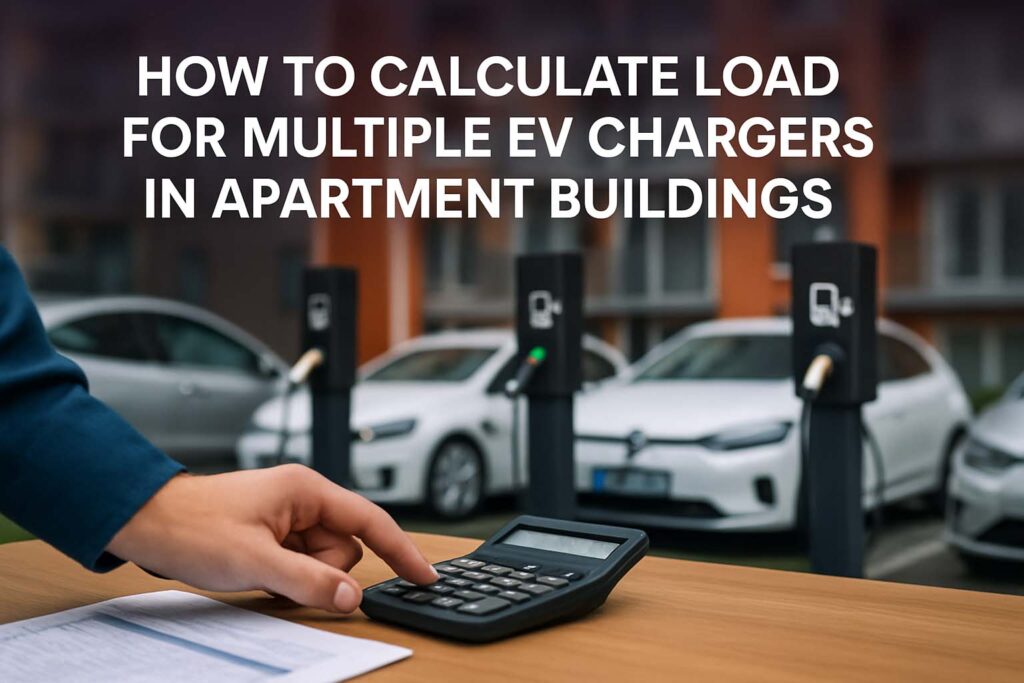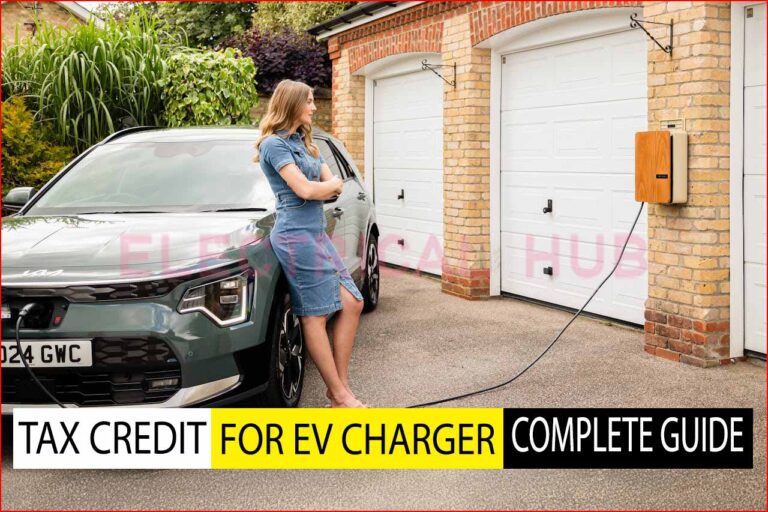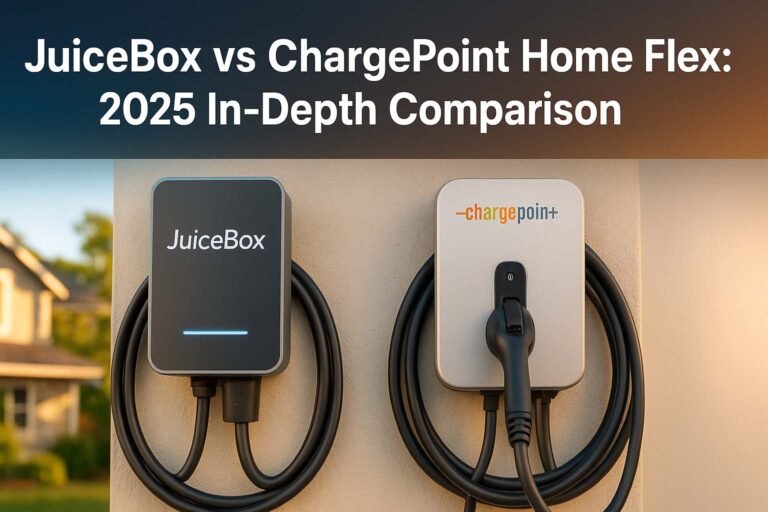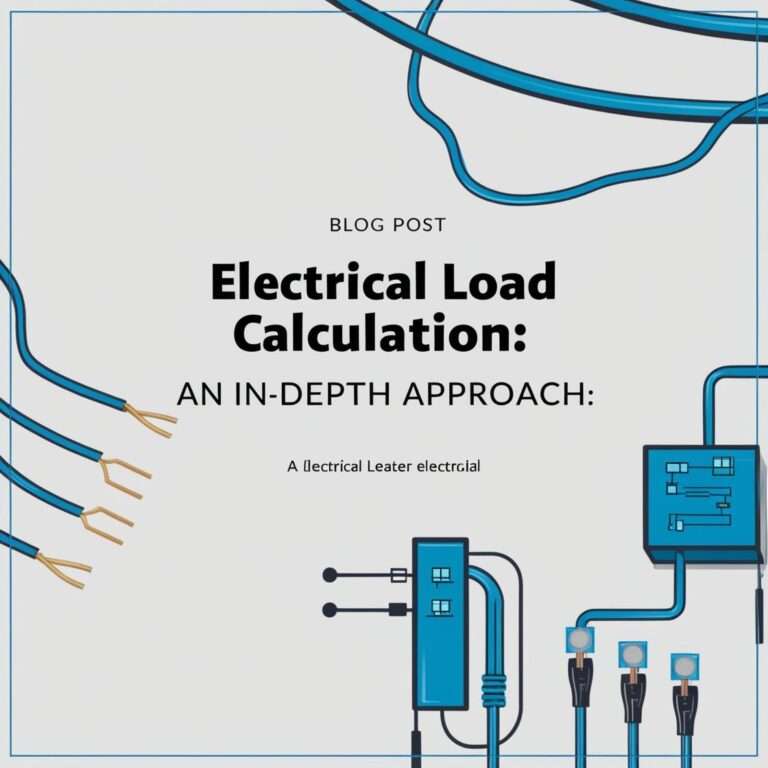How to Calculate Load for Multiple EV Chargers in Apartment Buildings
As electric vehicles (EVs) become more popular across Europe, apartment buildings face a unique challenge: how to install multiple EV chargers without overloading the building’s electrical system. Shared EV charging is now a growing demand, especially in urban settings where private garages are rare.

In this guide, we’ll show you how to calculate the EV charger load for flats, manage shared EV charging load, and plan your building EV infrastructure in Europe with confidence and accuracy.
Understanding the Basics of EV Charging Load
To begin calculating the electrical load, you need to understand how EV chargers work and how much power they consume. A typical EV charger comes in different power ratings:
| Charger Type | Power Rating (kW) | Charging Time (0–100%) |
|---|---|---|
| Level 1 (slow) | 2.3 – 3.7 kW | 8 – 12 hours |
| Level 2 (fast) | 7.4 – 22 kW | 2 – 6 hours |
| DC Fast Charging | 50 kW or more | 30 minutes – 1 hour |
In most apartment buildings, Level 2 chargers (usually 7.4 kW single-phase or 11 kW/22 kW three-phase) are used due to a balance of speed and cost.
Use our online tool for free What Gauge Wire Do I Need? Free Online Calculator for Electricians & Homeowners
Step-by-Step: Calculating EV Charger Load for Flats
Let’s say your building has 20 flats, and 10 residents are interested in EV chargers. Each charger is rated at 7.4 kW single-phase.
Step 1: Total Connected Load (Worst-Case Scenario)
Multiply the number of chargers by their individual rating:
10 EV chargers × 7.4 kW = 74 kW
This is your maximum connected load if all chargers run at full power simultaneously.
Know more about load calculation for ev charger
Step 2: Apply a Diversity Factor
In reality, all chargers don’t operate at full load at the same time. This is where diversity comes in.
Diversity Factor typically ranges from 0.4 to 0.6 for shared residential EV charging loads.
Let’s assume a diversity factor of 0.5:
Diversity-adjusted load = 74 kW × 0.5 = 37 kW
This adjusted value is much more practical and closer to real-world use.
Step 3: Convert kW to Amps
To size cables, breakers, and panels, convert the load from kilowatts to amps.
For single-phase supply:
Amps = (kW × 1000) / (Voltage × Power Factor)
Assume 230V and Power Factor of 1:
Amps = (37 × 1000) / 230 = 160.87 A
This is your total estimated current draw for 10 EV chargers with a diversity factor applied.
Know more about 7kW EV Charger Cost: A Detailed Guide
Technical Considerations for Shared EV Charging Load
Grid Connection Capacity
Before installation, verify the building’s maximum allowed load from the distribution network. If the current capacity is already near its limit, you may need to apply for a load extension or install load management systems.
Load Balancing System
A load management system (LMS) or dynamic load balancing ensures that EV chargers do not exceed the building’s electrical capacity. These systems allocate available power across all chargers in real-time.
Without this, simultaneous charging could trip breakers or damage infrastructure.
Cable Sizing and Trunking
Proper sizing is essential to avoid overheating and ensure voltage drop is within limits.
For a shared 160 A load over a 50-meter distance, you may need:
| Cable Type | Size (mm²) | Installation Method | Estimated Voltage Drop |
|---|---|---|---|
| XLPE SWA | 70 mm² | Underground/Ducted | ≤ 5% |
Your electrical engineer should confirm these values based on your building layout and local standards.
Building EV Infrastructure Europe: Compliance & Best Practices
Know the European Standards
EV infrastructure in Europe must comply with IEC 61851 (charging systems), IEC 60364-7-722 (electrical installations for EVs), and EU Directive 2014/94/EU for alternative fuel infrastructure.
Your planning should also consider:
- Local grid rules from utility providers
- Fire safety and ventilation in underground parking
- Communication protocols (OCPP, ISO 15118) for smart chargers
Know more about Portable EV Charger Level 2
Common Wiring Layouts in Apartment Blocks
There are three main approaches to wiring in multi-dwelling EV installations:
- Individual Meters per Flat – Each charger connects to its owner’s unit meter. Best when EV ownership is low.
- Shared Central Meter – All chargers run off a shared main meter and cost is split via software. Ideal for communities with shared usage.
- Sub-metering per Charger – Chargers are fed from a shared line, but consumption is tracked per user. Allows billing while simplifying cabling.
For 10–20 flats, sub-metering is often the most practical method.
How to Scale EV Charger Load for Future-Proofing
Planning for Expansion
Even if only 3 out of 20 flats have EVs now, demand will rise. It’s smart to pre-install:
- Larger cable trays
- Extra breakers
- Spare capacity in distribution boards
This avoids costly upgrades later.
Smart Charging & Scheduling
Using smart chargers with time-of-use control can reduce peak load. For example:
- Flat 1 charges from 10 PM to 2 AM
- Flat 2 charges from 2 AM to 6 AM
This load shifting spreads energy demand across the night.
Example Load Calculation Table – 20 Unit Apartment
| Scenario | No. of EV Chargers | Power per Charger | Diversity Factor | Total Load (kW) | Total Amps @230V |
|---|---|---|---|---|---|
| Initial Phase | 5 | 7.4 kW | 0.6 | 22.2 kW | 96.5 A |
| Medium Adoption (50% flats) | 10 | 7.4 kW | 0.5 | 37.0 kW | 160.9 A |
| Full Adoption (20 EVs) | 20 | 7.4 kW | 0.4 | 59.2 kW | 257.4 A |
Know more about Best Portable EV Charger: A Complete Guide
Utility Engagement and Permissions
Before any EV infrastructure project in a residential block, you must:
- Apply for approval from your local Distribution System Operator (DSO)
- Provide load assessment reports
- Get approval for cable routing in shared spaces
- In some countries like Germany or France, you may qualify for subsidies for shared EV charging projects
Final Thoughts on EV Charger Load for Flats
Designing shared EV charging systems for apartment buildings in Europe requires thoughtful planning, technical knowledge, and coordination with authorities. By calculating the EV charger load for flats using diversity factors, sizing your infrastructure smartly, and installing scalable systems, you can avoid overloads and prepare your building for the EV future.
Know more about Car Charger Demand Factor
The demand for shared EV charging load solutions is only going to increase. Whether you’re a facility manager, an electrical engineer, or a proactive tenant, understanding how to build smart, sustainable EV infrastructure for buildings in Europe is essential.
Follow Us on Social:
Subscribe our Newsletter on Electrical Insights to get the latest updates in Electrical Engineering.
#EVChargingLoad, #ApartmentEVCharging, #SharedEVCharging, #EVChargerLoadCalculation, #BuildingEVInfrastructure, #EVReadyApartments, #EVLoadManagement, #MultiUnitEVCharging, #EVInfrastructureEurope, #ElectricVehicleCharging, #EVChargerSetup, #SmartEVCharging, #EVLoadCalculator, #SustainableApartments, #EVFutureEurope





